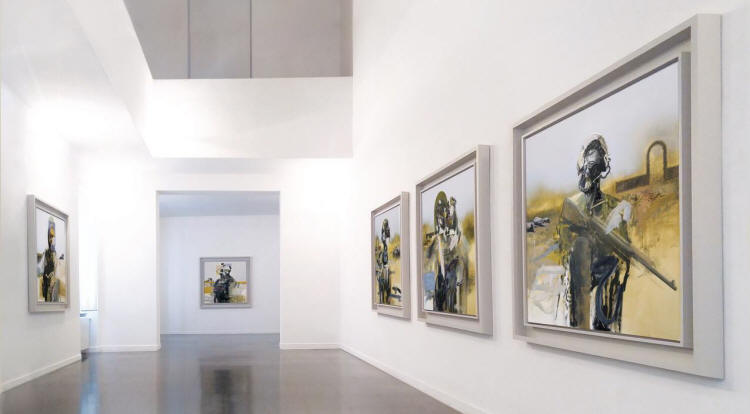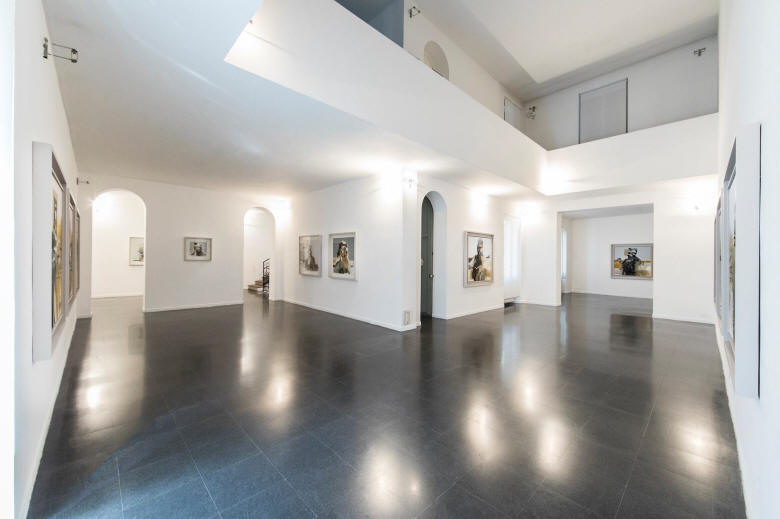|
|
| home | exhibitions | interviews | features | profiles | webprojects | archive |
|
The Existence Joseph Clarke Essay published for David Kim Whittaker's 'A Portrait for Human Presence' at Fondazione Mudima in Milan 6/6/17 - 7/7/17.
“From the standpoint of daily life, however, there is one thing we do know: that we are here for the sake of each other - above all for those upon whose smile and well-being our own happiness depends, and also for the countless unknown souls with whose fate we are connected by a bond of sympathy. Many times a day I realize how much my own outer and inner life is built upon the labors of my fellow men, both living and dead, and how earnestly I must exert myself in order to give in return as much as I have received”. Albert Einstein On embarking on the compiling of this publication on the enigmatic artwork of David Kim Whittaker and the curation of the related exhibition at the Fondazione Mudima in Milan, I have found it important to reflect on the purpose of centering my own life within the world of 'art'. This is a project I feel obligated to do full justice. I first met Whittaker 25 years ago. I was 16 years old, visiting St. Ives in Cornwall, England on family holiday. This small town was full of trashy tourist galleries, a twisted by-product mutating from an important post-war arts heritage combined with its picture perfect surroundings. Just away from the harbour front, I found a narrow passage way. Half way down, in a small unit, I first encountered a young, not fully artistically matured, David Kim standing alongside his imposing paintings. It seemed strange and askew. Brutal and confrontational. ‘He’ and ‘it’ didn’t fit at all with the surroundings. Amongst the trivial it was the first and only visceral encounter with something that hooked me in this strange little town. Of course this was many years ago and much has changed, but I mention it only to emphasize the importance of this task to me. Our paths have inter-twined for so long now. So to return to my questioning; why the field of ‘art'? I often feel baffled by our species. When I struggle to breath; 'arts' potential occasionally offers me a gulp of air. The objective world we create seems ever increasingly obsessed with logical observation. Finding answers to questions, often without first interrogating our requirements from those answers, or even if the questions pursued are of fundamental moral value or reward. 'Our' quantified world has become ever messy. The mysteries of which are only ever justified when answers can be clearly pointed at and measurements taken; when things are proven. Proof. I’ve never really understood it. For me it never seems to prove much at all. The true nature of reality has always been a little beyond my comprehension. Personally, I'm content with that; for everything to be possible and nothing fixed. So my ‘art’ world, the camp where I have pitched my existential tent, when functioning at its best, is a celebration of the metaphysical abstract over the empirical. Metaphysics continues to ask questions where science gives up, and it doesn’t even expect the answers. For me that is where truth hides, in the acceptance that ‘all' cannot be pinned down and will, and perhaps should, always be beyond us. Fundamental questions and the necessary faith that ensues, offer me far more comfort than proof. Carl Jung wrote in ‘The Archetypes and the Collective Unconscious’; “If it be true that there can be no metaphysics transcending human reason, it is no less true that there can be no empirical knowledge that is not already caught and limited by the a priori structure of cognition”.
David Kim Whittaker is the quintessential ontological artist, whose whole life has been an examination of what it is to be human, whilst simultaneously greeting the impossibility of the task. Instead the remaining (no small) duty is to catch the moth in the net for the briefest of moments, accepting that it must once again be set free. In an introduction I once wrote for David Kim I included the following from Lewis Carroll’s 1865 classic ‘Alice’s Adventures in Wonderland’: “Who are YOU?” said the Caterpillar. This was not an encouraging opening for a conversation. Alice replied, rather shyly, “I - I hardly know, sir, just at present - at least I know who I WAS when I got up this morning, but I think I must have been changed several times since then”. The story of a young Alice and her journey through Wonderland posits the notion that we are what we dream we will become. That identity is ambiguous, internal and ephemeral, our own warren to explore. Perhaps, where some of the tunnels remain blocked, consciously or unconsciously, through art they can be accessed. Philosophically it is an interesting concept that everything that we witness, think, dream, and have said to us can inform and indeed change the person that we are. Resulting in an ever-expanding maze of the self. Like Lorenz’s ‘Butterfly Effect’ which proposed that one flap of a butterfly’s wings can change the weather forever; any matter of stimulus can alter and inform what we are to become. We are all in a constant state of flux or metamorphosis. Heraclitus argued that change was ubiquitous; "You cannot step into the same river twice”. So I can't tell you who I am, or who David Kim Whittaker is, or expect you to be able to offer me the same service. On the wall of the studio is a clipping of a photograph of nine year old Alice Liddell (the real girl who inspired Carroll’s classic). I ask David Kim why the picture sits there modestly enshrined. He explains: "there she is at the start of her life, innocent and clearly full of imagination and possibility, alive and looking back at you. But now she’s gone and the rest becomes a history almost lost; like a trail of vapour, but a whisper echoes". Life and its transience is what David Kim grabs hold of; the paintings are a rabbit hole, which can always be escaped into. Metamorphosis remains a theme within the work, but also in his life (the two are inextricably linked). Over the past 8 years, Whittaker has been in a state of physical and psychological development since an official diagnosis of gender dysphoria. Outside of his career as an artist, in the day-to-day, David Kim lives as ‘Kim’, a woman. Within the career David Kim is accepting and embracing of this ‘trans’ state. It is what it is, neither or both, and explicitly provides an invaluable universal overarching context to the work. I emphasize universal, it is important to do so, as these paintings are for, and of, all of us. Whittaker’s complexity, integrity and fearlessness offer a distinctive and original voice. As Friedrich Nietzsche wrote in ‘Thus Spoke Zarathustra: A Book for All and None’: “One must still have chaos in oneself to be able to give birth to a dancing star”. These paintings, primarily of the head, illustrate a generic duality confined within the human condition, both the physical and the emotional manifested. Primal, archetypal male attributes transcend into a feminine space. This fusion informs us and allows us to contemplate our species achievement and development. All our complexity. Whittaker describes his studio trials as an endless artistic search for something as yet unseen where the works are born from moments of intense creativity, where they are pushed as far as possible. He finds the window to capture the image "relatively short before it disappears into itself". Moments of darkness and joy, from the cradle to the grave. The weeping, the brave face. The unpredictable nature of being. The complexities of gender. Thought and emotion, personal and universal; this is what David Whittaker describes as "the rapture of life". The studio is awash with iconic imagery which acts as stimulus to feed the soul and combines to create an inner sanctum. The space is an echo of the minds eye, yet there is always a sense of the world outside as his studio hovers in a former industrial office space over what he once described to me as "the scum ridden streets of Newquay", a typical weathered seaside town, in the far west of England. There is a sense of an embracing of this literal ‘inner’ and ‘outer’ duality in the mark-making, a celebration that perhaps the self-expressions that we see on the streets; the tattoos on flesh and vestiges from spray cans and marker pens run parallel to the marks made by alternative civilizations on indigenous tribal skin, in rococo graffito and scratched on to primeval cave walls. That we are merely another tribe paying homage to our past, recording our present and casting an echo in to the future through the markings that we make. All expressions of our uniquely human, universal story and as Georg Hegel once said it “World history is the record of the mind's effort to understand itself”.
Our experience of existence is where the 'inner' and the 'outer' world collide. Where the messy web of all that envelopes us, smothering and comforting, tearing and stroking takes place. The 'self' is the canvas placed at the centre of this universal battle. This discord saturates the work and is represented in part through fine, intricate representational painting alongside erratic, gestural, impasto, often violent mark-making. These differing techniques denote conflict but also manifest a place where fusion and harmony exist. We get to feel the blurring, celebratory and melancholic power of memory, the moments that aid transcendence and at the same time hint at our primal constituent. There are ghostly images of places once visited or perhaps seen third hand in a picture, scraps of paper torn from journals once read; a story that may have moved or merely caught peripheral attention. This clinging to things that nourish our senses acknowledges that our influences and experiences become part of the fabric of who we are, fusing with our DNA. These abstracted, fragmented, human heads act as two way mirrors; a life’s moment as a small reflection on the whole of humanity. Works are often underpinned by delicate drawing created through repetitive 'prayer-like' scrawling and stenciling of found abandoned objects; lost keys, dropped coins and trinkets. Lives are traced through this discarded ephemera. A watermark is created that spirals outwards, as fluid patterns flow across the board. Cellular, bodily; molecular and cosmic. Both chaotic and intricate. Individual lost stories of the mundane and the weighty are showcased in these works; triviality and reverie collide with loss and suffering, fragility and thoughts of escape. The paintings are heavy, romantic, and sometimes tragic, whilst still remaining comfortingly prosaic. Through this sharing we are propositioned to contemplate that we may be isolated but we are not alone. I am so proud to have witnessed first hand the development of this phenomenal and phenomenological artist. David Kim Whittaker’s ambition has been to make something monumental about the human condition that has not been seen before. To make paintings that lay down a marker or send out an echo of this life, reflecting some of the messiness of existence alongside inner utopian desire and potential. I’ve seen first hand that making work has helped Whittaker to come to terms with his own existence. An essence has been captured that will forever remain a window for others to peer through, and in the reflection of these panels, perhaps you will catch a glimpse of yourself.
Joseph Clarke is an independent curator, writer, film maker and gallery director. |
|
|


